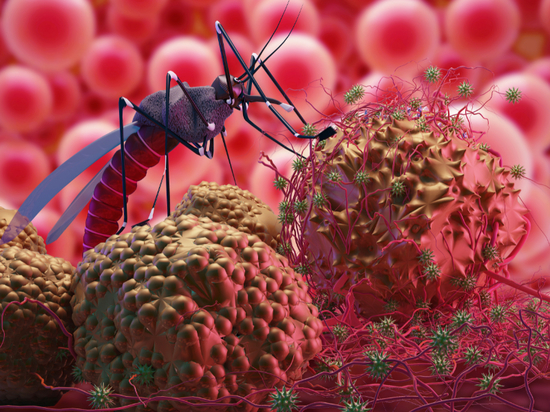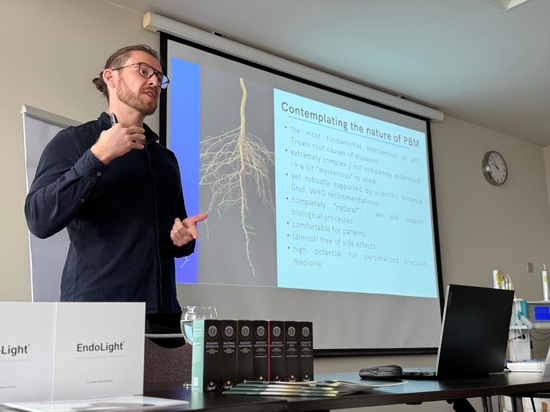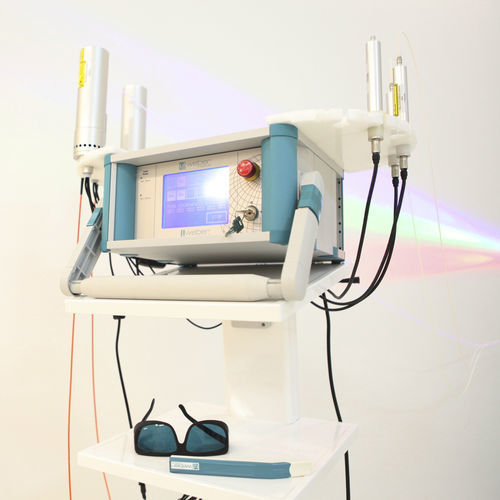
#Product Trends
Intravenous low-level-laser-therapy with the Weber Medical Endolaser©
Reasons to consider adding the Weber Medical Endolaser© to your clinic
Summary
This article provides a brief overview about low-level-laser-therapy in general by introducing its mechanisms of action and most common areas of application. Among these, the intravenous application of low-level-lasers is a relatively new development that goes along with several advantages over more traditional applications. Readers will find lists of the benefits of intravenous low-level-laser-therapy and conditions in which the approach is useful as well as a description of how the therapy is being carried out. Another section describes how medical professionals can benefit from adding the Weber Medical Endolaser© to their clinics. The last part provides links and references to more educational content that pertains the therapy.
Low-level-laser-therapy: A short overview
Low-level-laser-therapy (“LLLT” - also called cold laser therapy, low power laser therapy, soft laser or photobiomodulation) is a non-invasive respectively minimal-invasive method of treatment in which the body is exposed to laser light of low intensity (up to 500mW). The therapy stimulates and regenerates cells and tissues and accelerates healing processes. Unlike surgical lasers, LLLT is non-destructive, and painless and works on bio-stimulation. In many cases, it is a fantastic alternative to surgery and/or drugs and allows physicians to treat root causes of diseases instead of only symptoms.
Its mechanisms of action can be compared to photosynthesis in plants where sunlight is absorbed and then converted to usable energy so the plant can grow. In humans and animals, the light energy is absorbed by and interacts with light-sensitive elements in our cells which are called chromophores. In the resulting processes, the light energy is transformed into biochemical energy which increases cellular regeneration and cellular communication and stimulates the production of a variety of beneficial chemicals within the body that are then released and carried by the blood and lymphatic flow to other parts of the system. The best researched chromophore and most famous example is the so called complex IV of the respiratory chain at the inner mitochondrial membrane: Cytochrome C Oxidase. However, there are many other known light-absorbing components in the human body, e.g. flavoproteins, peroxidases, porphyrins, catalases, and cytochromes.
At the beginning of the 21st century, topical low-level-laser-therapy became a common modality to treat pain, sports injuries, inflammatory conditions, skin conditions and wounds. The term “topical” describes the application of lasers on the skin (typically with wavelengths out of the red and infrared light spectrum) from where the light can penetrate 2-3cm deep if red lasers are being used and around 5cm deep if infrared lasers are being used. However, colors out of the shorter wavelengths-spectra such as
ultraviolet, blue, green, and yellow do not penetrate the skin well enough to reach deeper layers of the body. To use these colors of light therapeutically, LLLT must be applied in a minimal-invasive manner. Advanced technology such as the Weber Medical Endolaser© nowadays allows for intravenous, interstitial, intra-articular, transurethral, and various endoscopic applications of LLLT, enabling physicians to deliver the light energy to basically all parts of the body (in the rest of this short article, we only focus on the intravenous application).
These developments expanded the scope of therapeutic use for LLLT to various systemic diseases which are listed below.
The therapy is fully CE- approved and can be used by medical doctors, naturopathic doctors, dentists, physical therapists, and other medical professionals in a variety of ways.
Benefits of intravenous low-level-laser-therapy
The benefits of Intravenous Low-level-laser-therapy include:
- Boosting cellular energy by increase of ATP synthesis
- Growth factor response within cells and tissue
- Strengthening of immune system response via increasing levels of lymphocyte activity and activation of macrophages
- Improvement of microcirculation and reduction of blood viscosity
- Improved cell proliferation; change in cell membrane permeability to calcium uptake
- Positive effects on heart and metabolism
- Improvement of function, behavior and cell elasticity of red blood cells
- Improvement of Oxygen Delivery
- Activation of reparative and stabilizing pathways
- Release of Nitric oxide (NO) and activation of telomerase
- Brings down blood pressure
- Reduction of inflammations
- Pathogen deactivation (effective against bacteria and viruses)
- Detoxifying effects
- Positive influence on the general mood (anti-depressive effects)
- Improvement of Serotonin and Vitamin-D production
- Pain relief as a result of increased endorphin and serotonin release + suppression of nociceptive action
- Positive effects on the hormone system
- Activation of stem cells
Conditions for which intravenous low-level-laser-therapy is useful
- Diabetes mellitus
- Chronic liver and kidney diseases
- Lipid metabolic disorder
- Heart diseases
- Chronic shoulder syndromes
- Allergies and eczema
- Fibromyalgia
- Pain
- Rheumatism
- Hypertension
- Tinnitus
- Macular degeneration
- Multiple Sclerosis
- Depression
- CFS (chronic fatigue syndrome)
- Panic attacks and anxiety disorder
- Lyme disease
- Infertility
- Anti- aging
- Infectious Diseases (via Photodynamic Therapy)
- Integrative Cancer Care (via Photodynamic Therapy)
How the therapy is being conducted
During intravenous laser therapies, a butterfly needle is being inserted into a peripheral vein in the forearm. Afterwards, a fiber optic intravenous catheter is being passed through the lumen of the butterfly. On its other side, the intravenous catheter is connected to the laser diode through a fiber optical cable. The laser light is being delivered directly to the bloodstream through this catheter- butterfly- system.
Treatments typically last from 30 – 60 minutes and are repeated about 8-10 times within the first 4 weeks of the regime. Afterwards, follow-up-therapies are often conducted 2-4 times a month, depending on the indication and health status of the patient.
Patients usually feel nothing during the procedure, although slight feelings of tingling sensations due to the increased blood flow to the area being treated are observed from time to time. The actual effects of laser therapy begin at the time of treatment, but generally only become noticeable several hours or even days after.
The whole procedure is shown and explained in this video:
https://www.youtube.com/watch?v=Ika1GkefjSU&list=PLwmaC9-LsMKDP89IjVZghqcmjpkIEfwau&index=2
Reasons to consider adding the Weber Medical Endolaser© to your clinic
There are several reasons how the Weber Medical Endolaser© can increase the value of your clinic.
First, you acquire the only multi-modality device on the world-market that at the same time facilitates all commonly used and all novel application of low-level-laser-therapy in just one device. This includes laser acupuncture as well as topical, transcranial, intravenous, interstitial, intra-articular, transurethral, and various endoscopic applications. It can also be used for all kinds of photodynamic therapies, incl. its application to treat infectious diseases and cancer.
The set-up can be chosen according to the needs and budget of the respective medical professional and the modular design allows for product upgrades (e.g. adding of more laser diodes) at any time.
The range of available laser colors (wavelengths) is unique on the world-market and includes ultraviolet, blue, green, yellow, red and infrared lasers with different output powers and different wavelengths within the respective color spectrums.
Different disposables and accessories are available at reasonable prices and allow physicians to deliver the laser light to basically all areas of the body.
The Endolaser© is made in Germany and therefore meets the highest safety and product design requirements, making it extremely easy and safe to operate the device. The time required to conduct the therapies is little – physicians will only be busy for about 5 minutes in order to initiate a one-hour-therapy-session. Furthermore, nurses can take care of most - sometimes all - steps of the procedure.
The integrated touchscreen panel allows physicians to quickly and easily adjust the therapy parameters with regard to the applied intensity of the light (measured in mW) as well as the treatment duration and also allows the setting of frequencies (measured in Hz) on all laser diodes.
The therapy is painless, requires no anesthesia and does not cause side-effects. It can also be combined with many other approaches and increases the efficacy of therapies such as Platelet-Rich-Plasma-Therapies (PRP), Ozone-Therapies, Oxygen-Therapies or IV-Infusion-Therapies.
Educational content
1.) LLLT- database
A huge LLLT- database with 5.000+ studies and articles can be found here:
https://docs.google.com/spreadsheets/d/1ZKl5Me4XwPj4YgJCBes3VSCJjiVO4XI0tIR0rbMBj08/edit?fbclid=IwAR3CLbYjl-H73Rhuzq8-yb01YQ_aOU_E8xKX0GIDBbSi2EuplfqQAmT7644#gid=0
2.) Videos
2a.) The Weber Medical-Youtube-channel contains several videos that explain the conduct of various therapies:
https://www.youtube.com/channel/UCheWGOQGkqbIVgAtHf0hqdQ
2b.) Dr. Michael Weber speaks about the history of modern laser therapy and provides an overview about the mechanisms of action, areas of application, state of research and the technology that he developed (125 min):
https://www.youtube.com/watch?v=22Gf8VWiUKo&t=3s
2c.) Dr. Michael Weber in a podcast with Dr. Michael Karlfeldt, providing an overview about the field of laser therapy with a focus on photodynamic therapy (43 min):
https://www.youtube.com/watch?v=PfFE9e9eDVw&t=1056s
3.) ISLA (International Society for Medical Laser Applications)
The ISLA is a non-profit scientific organization that conducts research and offers education in low-level-laser-therapy. Part of the
educational content are three annual conferences (taking place in Germany, the US and Thailand) and shorter one-day-seminars
in different countries. The organization also currently develops a LLLT-online-training-program and has published a comprehensive
LLLT-handbook.
To receive information about conference dates and more, send an email to:
martin.junggebauer@gmail.com





